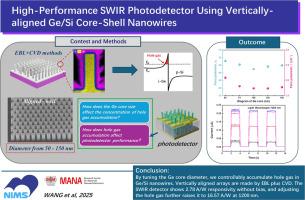High-performance SWIR photodetector using vertically-aligned Ge/Si core–shell nanowires
IF 14.3
1区 材料科学
Q1 MATERIALS SCIENCE, MULTIDISCIPLINARY
引用次数: 0
Abstract
Ge/Si core–shell nanowires (CSNWs) are regarded as strong candidates for next-generation electronic and optoelectronic devices, as they have a structure in which the carrier transport region is isolated from the impurity-doped region by hole gas that has accumulated between the interfaces. In this study, vertically-aligned i-Ge/p-Si CSNWs with different diameters were successfully fabricated using the top-down method, employing electron beam lithography (EBL) combined with chemical vapor deposition (CVD). Raman analysis exhibits hole gas accumulation that is clearly controllable by adjusting the size of the Ge core. A high-performance short-wave infrared (SWIR) photodetector was fabricated using i-Ge/p-Si CSNWs. Even without applied bias voltage, maximum responsivity reached 2.78 A/W under illumination with 1200 nm (near infrared) light. Maximum responsivity reached 16.57 A/W by controlling the hole gas concentration. Our results confirm that hole gas accumulation in i-Ge/p-Si CSNWs enables the fabrication of high-performance SWIR photodetectors.

使用垂直排列的Ge/Si核壳纳米线的高性能SWIR光电探测器
Ge/Si核壳纳米线(CSNWs)被认为是下一代电子和光电子器件的有力候选者,因为它们具有一种结构,在这种结构中,载流子输运区与杂质掺杂区被界面之间积累的空穴气体隔离。本研究采用电子束光刻(EBL)和化学气相沉积(CVD)相结合的方法,成功制备了垂直排列的不同直径的i-Ge/p-Si CSNWs。拉曼分析表明,通过调整锗核的大小,可以明显地控制空穴气体聚集。采用i-Ge/p-Si CSNWs制备了高性能短波红外(SWIR)光电探测器。即使没有施加偏置电压,在1200 nm(近红外)光照射下,最大响应度达到2.78 A/W。通过控制井内气体浓度,最大响应度可达16.57 A/W。我们的研究结果证实,在i-Ge/p-Si CSNWs中,空穴气体积累可以制造高性能的SWIR光电探测器。
本文章由计算机程序翻译,如有差异,请以英文原文为准。
求助全文
约1分钟内获得全文
求助全文
来源期刊

Journal of Materials Science & Technology
工程技术-材料科学:综合
CiteScore
20.00
自引率
11.00%
发文量
995
审稿时长
13 days
期刊介绍:
Journal of Materials Science & Technology strives to promote global collaboration in the field of materials science and technology. It primarily publishes original research papers, invited review articles, letters, research notes, and summaries of scientific achievements. The journal covers a wide range of materials science and technology topics, including metallic materials, inorganic nonmetallic materials, and composite materials.
 求助内容:
求助内容: 应助结果提醒方式:
应助结果提醒方式:


